The automotive market is always buzzing with new contenders vying for the attention of consumers, and two models that stand out in the compact segment are the Kia Stonic and the Renault Clio. Both vehicles cater to urban drivers seeking style, efficiency, and modern features, yet they do so in unique ways. Let’s dive into the comparison of these two fascinating models, focusing on their technical aspects, innovations, and overall appeal.
Kia Stonic vs Renault Clio – Which one offers the better deal?
Two cars, one duel: Kia Stonic meets Renault Clio.
Which one wins in performance, efficiency and value for money? Find out now!
Design and Dimensions
Starting with aesthetics, the Kia Stonic showcases a robust SUV-inspired design that offers a commanding presence on the road. Its dimensions include a length of 4140 mm, a width of 1760 mm, and a height of 1505 mm, providing a spacious interior for its five occupants.
On the other hand, the Renault Clio adopts a hatchback profile that is sleek and stylish. Measuring 4053 mm in length, 1798 mm in width, and 1440 mm in height, the Clio presents a compact footprint, ideal for urban navigation while still accommodating five passengers comfortably.
Engine Options and Performance
When it comes to powertrains, the Kia Stonic offers a choice of petrol and MHEV options. With horsepower ranges from 79 to 100 HP, it strikes a balance between performance and efficiency. The Stonic's 1.0L engine has a torque output of 172 Nm, and it can accelerate from 0-100 km/h in a respectable 11.3 seconds, reaching a top speed of 179 km/h with a fuel consumption of around 5.5 L/100 km.
In contrast, the Renault Clio brings a more diverse lineup with options including full hybrid, petrol, and LPG engines, ranging from 67 HP to 143 HP. The Clio offers impressive acceleration, taking just 9.3 seconds to reach 0-100 km/h, thanks to its powerful 1.6L hybrid engine, while maintaining competitive fuel efficiency at approximately 4.3 L/100 km. Torque can go up to 205 Nm, making it quite lively in city conditions.
Innovative Features
Looking at innovations, the Kia Stonic includes features such as a user-friendly infotainment system, advanced safety technologies, and ample cargo space of 352 liters. With a fuel tank capacity of 45 liters, the Stonic offers great range for city and highway driving.
The Renault Clio, however, sets itself apart with its advanced driver assistance systems and outstanding fuel efficiency due to hybrid technology. It also boasts a sophisticated infotainment system accompanied by a smaller yet versatile trunk space ranging from 301 liters to 391 liters depending on the variant. Its fuel tank capacity sits between 32 and 42 liters, tailored for urban commuting.
Comfort and Interior Quality
Inside the Stonic, passengers can expect a spacious cabin with modern aesthetics and quality materials, contributing to a comfortable ride, especially for long journeys. The seating capacity for five adults ensures that families and groups can traverse the cities in style.
Meanwhile, the Renault Clio's interior is designed with a focus on comfort and style, offering an intuitive layout with high-quality finishes. It also provides several configurable options for seating and cargo layout, ensuring flexibility for varying needs.
Environmental Considerations
When evaluating the CO2 emissions, the Kia Stonic maintains a range of 125 to 132 g/km, which is competitive within its segment. The Renault Clio, especially with its hybrid variant, performs better in this area, achieving emissions as low as 97 g/km, appealing to environmentally-conscious consumers.
Conclusion
In conclusion, both the Kia Stonic and Renault Clio offer compelling options in the compact car market. The Stonic excels in delivering SUV-like practicality with modern features, while the Clio stands out with its innovative engine choices and environmental efficiency. Ultimately, the choice will depend on individual preferences regarding performance, style, and technological needs. As both models continue to evolve, they will undoubtedly remain popular choices for savvy urban drivers.
Here’s where it gets real: The technical differences in detail
Costs and Efficiency:
When it comes to price and running costs, the biggest differences usually appear. This is often where you see which car fits your budget better in the long run.
Renault Clio has a evident advantage in terms of price – it starts at 16600 £, while the Kia Stonic costs 20100 £. That’s a price difference of around 3549 £.
Fuel consumption also shows a difference: Renault Clio manages with 4.10 L and is therefore evident more efficient than the Kia Stonic with 5.60 L. The difference is about 1.50 L per 100 km.
Engine and Performance:
Under the bonnet, it becomes clear which model is tuned for sportiness and which one takes the lead when you hit the accelerator.
When it comes to engine power, the Renault Clio has a noticeable edge – offering 158 HP compared to 115 HP. That’s roughly 43 HP more horsepower.
In acceleration from 0 to 100 km/h, the Renault Clio is evident quicker – completing the sprint in 8.30 s, while the Kia Stonic takes 10.70 s. That’s about 2.40 s faster.
In terms of top speed, the Kia Stonic performs minimal better – reaching 182 km/h, while the Renault Clio tops out at 180 km/h. The difference is around 2 km/h.
There’s also a difference in torque: Renault Clio pulls barely noticeable stronger with 205 Nm compared to 200 Nm. That’s about 5 Nm difference.
Space and Everyday Use:
Cabin size, boot volume and payload all play a role in everyday practicality. Here, comfort and flexibility make the difference.
Both vehicles offer seating for 5 people.
In curb weight, Renault Clio is slight lighter – 1124 kg compared to 1205 kg. The difference is around 81 kg.
In terms of boot space, the Renault Clio offers barely noticeable more room – 391 L compared to 352 L. That’s a difference of about 39 L.
In maximum load capacity, the Renault Clio performs hardly perceptible better – up to 1176 L, which is about 21 L more than the Kia Stonic.
When it comes to payload, Renault Clio hardly perceptible takes the win – 463 kg compared to 445 kg. That’s a difference of about 18 kg.
Who comes out on top?
Overall, the Renault Clio shows itself to be wins the duel decisively and secures the title of DriveDuel Champion.
It convinces with the more balanced overall package and proves to be the more versatile choice for everyday use.
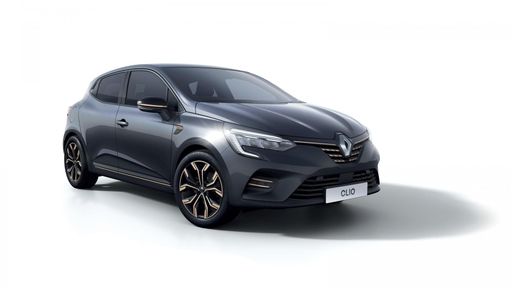 @ Renault Group Media
@ Renault Group Media
Renault Clio
Kia Stonic
The Kia Stonic is a sprightly compact crossover that mixes city-friendly agility with a cheeky, modern design — perfect for buyers who want style without sacrificing sense. Inside it serves up clever practicality and a bright, well-equipped cabin, making everyday driving feel a bit more fun than it has any right to be.
details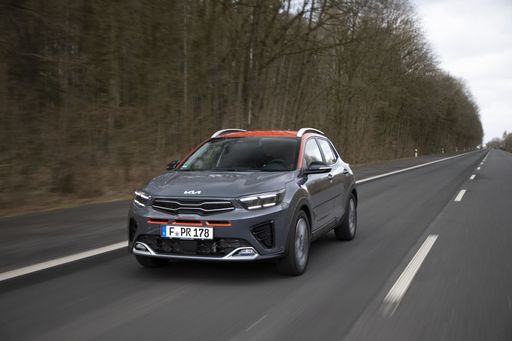 @ Kia Corporation
@ Kia Corporation
 @ Kia Corporation
@ Kia Corporation
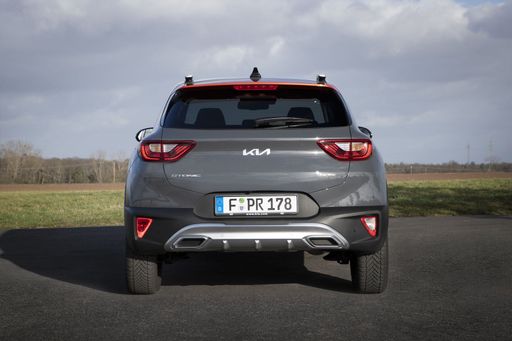 @ Kia Corporation
@ Kia Corporation
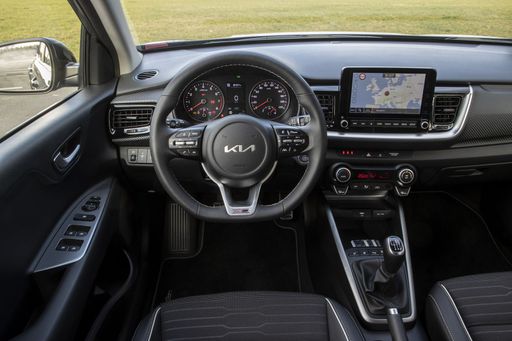 @ Kia Corporation
@ Kia Corporation
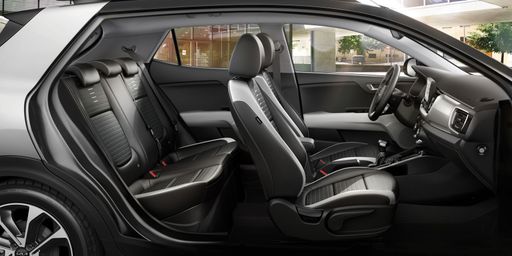 @ Kia Corporation
@ Kia Corporation
Renault Clio
The Clio punches above its weight with chic French styling and a surprisingly grown-up cabin that makes city driving feel effortlessly stylish. It's an easy-to-live-with choice that keeps ownership simple and even manages to put a grin on your face when the traffic gets dull.
details @ Renault Group Media
@ Renault Group Media
 @ Renault Group Media
@ Renault Group Media
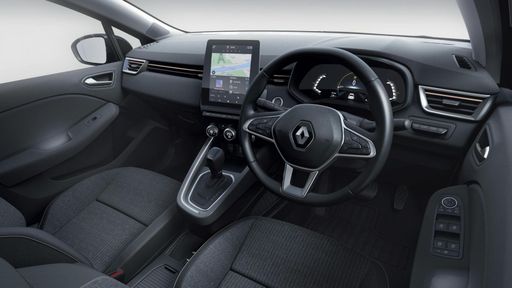 @ Renault Group Media
@ Renault Group Media
 @ Kia Corporation
@ Kia Corporation
|
 @ Renault Group Media
@ Renault Group Media
|
|
|
|
Costs and Consumption |
|
|---|---|
|
Price
20100 - 26600 £
|
Price
16600 - 23700 £
|
|
Consumption L/100km
5.6 - 5.9 L
|
Consumption L/100km
4.1 - 5.3 L
|
|
Consumption kWh/100km
-
|
Consumption kWh/100km
-
|
|
Electric Range
-
|
Electric Range
-
|
|
Battery Capacity
-
|
Battery Capacity
0.60 kWh
|
|
co2
127 - 133 g/km
|
co2
92 - 121 g/km
|
|
Fuel tank capacity
45 L
|
Fuel tank capacity
39 - 42 L
|
Dimensions and Body |
|
|---|---|
|
Body Type
SUV
|
Body Type
Hatchback
|
|
Seats
5
|
Seats
5
|
|
Doors
5
|
Doors
5
|
|
Curb weight
1205 - 1270 kg
|
Curb weight
1124 - 1331 kg
|
|
Trunk capacity
352 L
|
Trunk capacity
301 - 391 L
|
|
Length
4165 mm
|
Length
4053 - 4116 mm
|
|
Width
1760 mm
|
Width
1768 - 1798 mm
|
|
Height
1520 mm
|
Height
1440 - 1451 mm
|
|
Max trunk capacity
1155 L
|
Max trunk capacity
979 - 1176 L
|
|
Payload
440 - 445 kg
|
Payload
398 - 463 kg
|
Engine and Performance |
|
|---|---|
|
Engine Type
Petrol, Petrol MHEV
|
Engine Type
Full Hybrid, Petrol
|
|
Transmission
Manuel, Automatic
|
Transmission
Automatic, Manuel
|
|
Transmission Detail
Manual Gearbox, Dual-Clutch Automatic
|
Transmission Detail
Automatic Gearbox, Manual Gearbox, Dual-Clutch Automatic
|
|
Drive Type
Front-Wheel Drive
|
Drive Type
Front-Wheel Drive
|
|
Power HP
100 - 115 HP
|
Power HP
67 - 158 HP
|
|
Acceleration 0-100km/h
10.7 - 12.1 s
|
Acceleration 0-100km/h
8.3 - 17.1 s
|
|
Max Speed
179 - 182 km/h
|
Max Speed
160 - 180 km/h
|
|
Torque
172 - 200 Nm
|
Torque
95 - 205 Nm
|
|
Number of Cylinders
3
|
Number of Cylinders
3 - 4
|
|
Power kW
74 - 85 kW
|
Power kW
49 - 116 kW
|
|
Engine capacity
998 cm3
|
Engine capacity
999 - 1789 cm3
|
General |
|
|---|---|
|
Model Year
2025
|
Model Year
2023 - 2026
|
|
CO2 Efficiency Class
D
|
CO2 Efficiency Class
C, D, B
|
|
Brand
Kia
|
Brand
Renault
|
Is the Kia Stonic offered with different drivetrains?
The Kia Stonic is offered with Front-Wheel Drive.
The prices and data displayed are estimates based on German list prices and may vary by country. This information is not legally binding.
